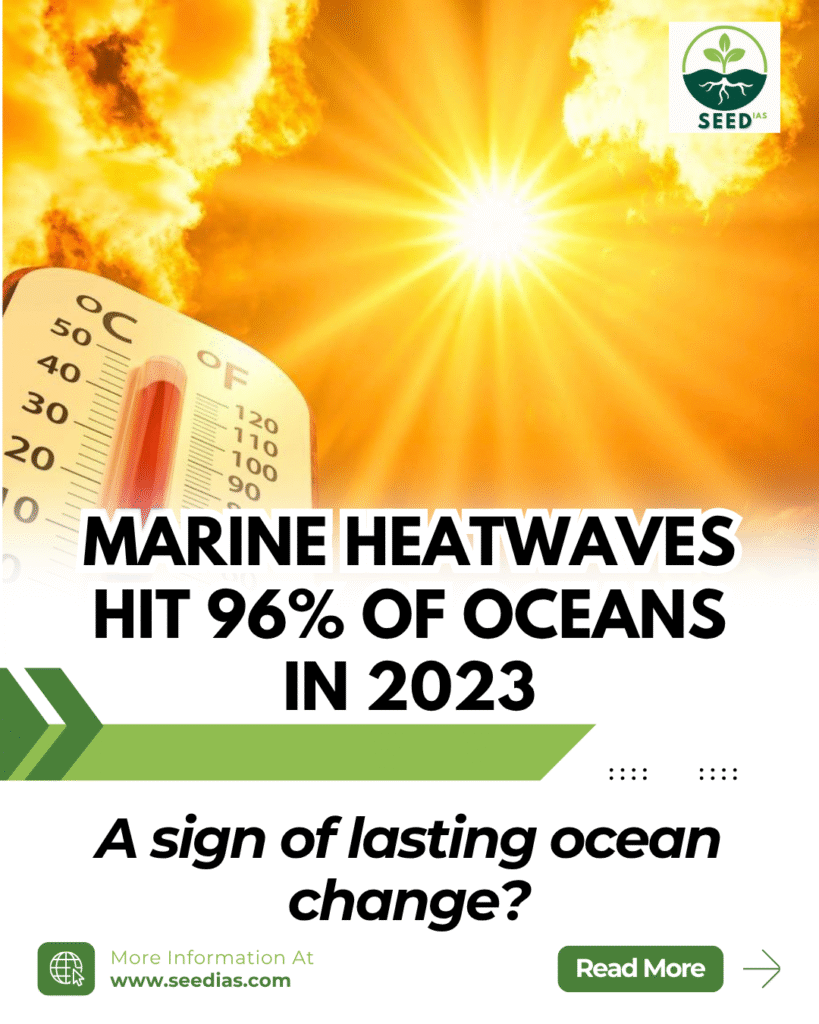Why in NEWS
Scientists revealed that 96% of the ocean surface experienced marine heatwaves (MHWs) in 2023, raising fears of a permanent ocean temperature shift, with cascading impacts on marine life, climate, and economies.
Key Terms and Concepts
| Term | Explanation |
|---|---|
| Marine Heatwave (MHW) | Period when sea surface temperatures remain abnormally high (3–4°C above normal) for at least 5 consecutive days |
| El Niño | Climate pattern causing warming of central and eastern Pacific Ocean, disrupting global weather |
| Pacific Decadal Oscillation (PDO) | Long-term Pacific Ocean temperature variability pattern, amplifies marine heatwaves |
| Feedback Loop | Self-reinforcing cycle where change (like warming) leads to further change (like ice loss) |

Causes of Marine Heatwaves
| Cause | Description |
|---|---|
| Global Warming | Oceans absorb 90% of Earth’s excess heat due to rising CO₂, increasing MHW frequency |
| El Niño & PDO | El Niño warms ocean surfaces; PDO alters Pacific temperatures, enhancing MHWs |
| Reduced Cloud Cover | Less cloud cover allows more solar radiation, causing rapid ocean warming |
| Changing Ocean Currents | Weakening currents (e.g., Gulf Stream) trap heat regionally, altering sea temperatures |
| Arctic Feedback Loops | Melting ice exposes darker ocean that absorbs more heat, intensifying warming |
| Coral Collapse | Dying coral reefs reduce CO₂ absorption, accelerating global temperature rise |
Impacts of Marine Heatwaves
| Category | Impact |
|---|---|
| Climate | Triggers extreme weather—hurricanes, floods, droughts, wildfires (e.g., Hurricane Ian) |
| Economy | Affects aquaculture and fisheries; reduces catch (lobsters, snow crabs, scallops) |
| Ecology | Mass invertebrate deaths, invasive species spread, food web disruptions, kelp/coral destruction |
| Compounding Stressors | Often occurs with acidification, deoxygenation, and overfishing—multiplying damage |
Mitigation and Prevention Measures
| Strategy | Key Actions |
|---|---|
| Strengthen Ocean Monitoring | Expand monitoring systems, improve predictive climate models |
| Protect Marine Ecosystems | Conserve coral reefs, mangroves, seagrasses; create Marine Protected Areas |
| Climate-Resilient Aquaculture | Promote heat-tolerant species, issue early alerts for fishers |
| Enhance Global Cooperation | Support Paris goals, aid vulnerable nations, strengthen ocean treaties (UNCLOS, UN Ocean Decade) |
| Reduce GHG Emissions | Shift to renewables, carbon pricing, clean industries and transport |
| Cut Local Ocean Stress | Reduce pollution (UN Plastic Treaty), adopt sustainable farming, explore artificial ocean cooling |
In a Nutshell
Memory Code – H.E.A.T.S.
Heat absorption by oceans
El Niño & feedback loops
Aquatic biodiversity loss
Triggering weather extremes
Solutions: global cooperation, emission cuts, ecosystem protection
Prelims Practice Questions
- Which of the following contributes directly to the formation of marine heatwaves?
A. Increase in cloud cover
B. Strengthening of the Gulf Stream
C. El Niño events
D. Sudden increase in volcanic activity - Marine Heatwaves often result in which of the following?
1.Coral bleaching
2.Disruption of food chains
3.Decreased ocean deoxygenation
Select the correct answer:
A. 1 and 2 only
B. 1 and 3 only
C. 2 and 3 only
D. 1, 2 and 3 - Consider the following:
1.Seagrass meadows
2.Kelp forests
3.Mangrove swamps
Which of the above are vulnerable to marine heatwaves?
A. 1 and 2 only
B. 2 and 3 only
C. 1 and 3 only
D. 1, 2 and 3
Mains Practice Questions
- Marine Heatwaves are emerging as a major threat to ocean biodiversity and climate stability. Examine the causes and suggest a multi-level strategy to mitigate their impact. 10 Marks (GS3: Environment)
- How do marine heatwaves interact with other stressors like ocean acidification and deoxygenation? Discuss their combined effects on coastal economies and global weather systems. 15 Marks (GS1/GS3 – Geography & Environment)
Prelims Answers and Explanations
| Qn | Answer | Explanation |
|---|---|---|
| 1 | C | El Niño warms the ocean surface and contributes to marine heatwave events |
| 2 | A | MHWs cause coral bleaching and disrupt food webs; they worsen deoxygenation, not decrease it |
| 3 | D | All listed ecosystems are highly vulnerable to sustained temperature rise from MHWs |
















